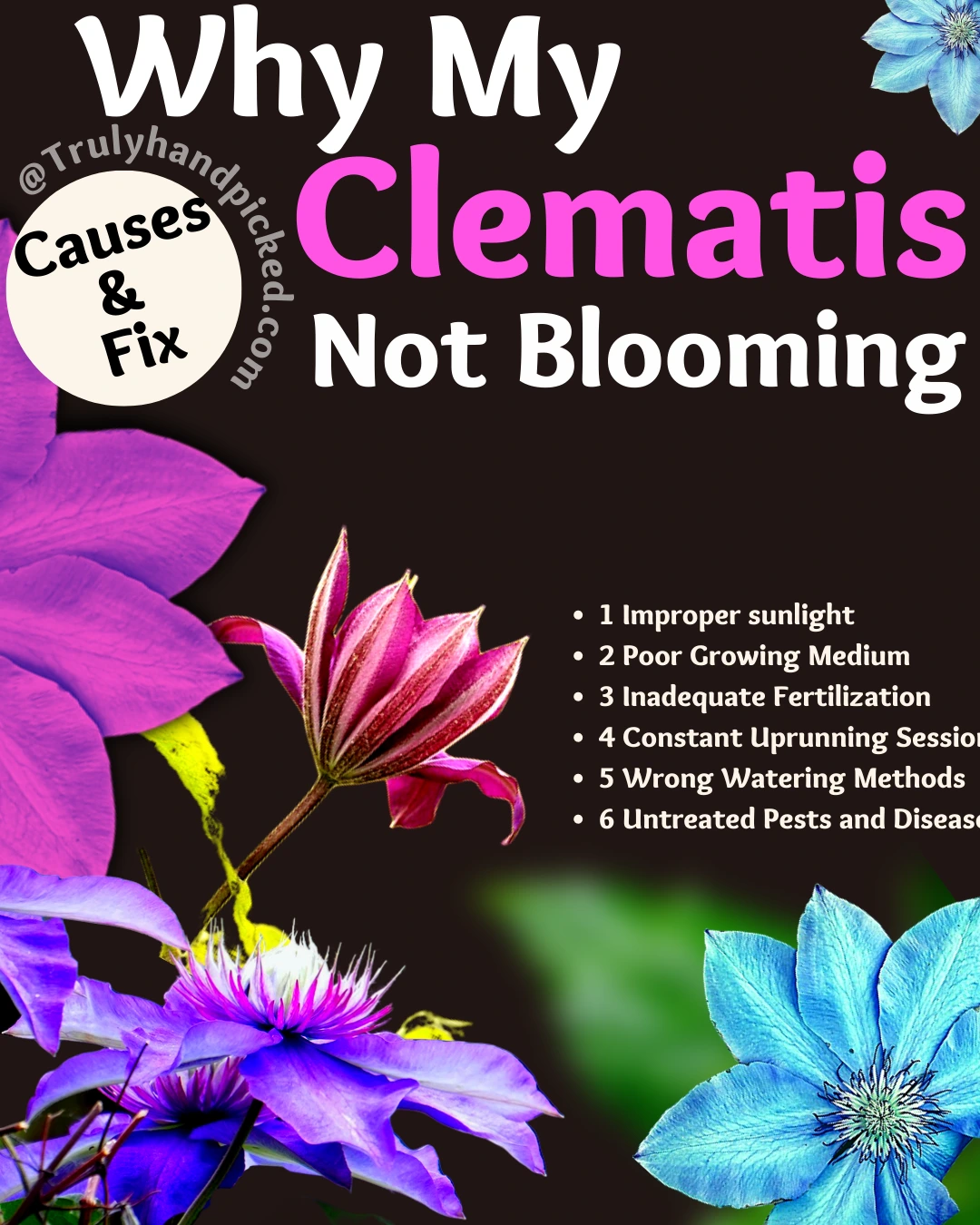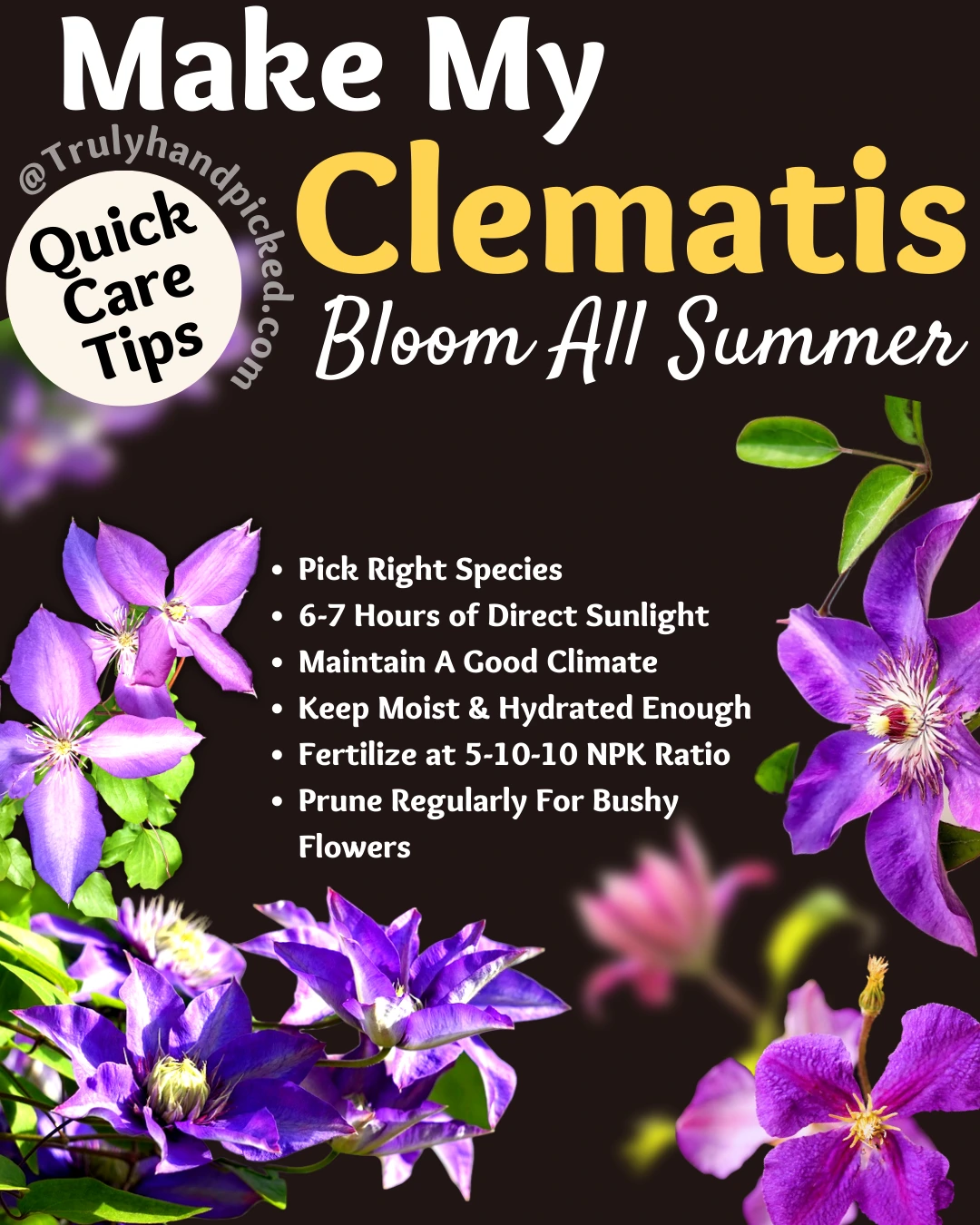Clematis, this flowering vine that can enhance the beauty of your yard excitingly. This perennial profile climber is a low-maintenance vine that produces blossoms in various bright shades and with different shapes, depending on their selective species.
This pretty-looking flowering climber is divided into two specific diversions, small-petal flowers, and large-petal flowers. Both varieties need similar types of care to thrive, bloom and hold their flowers for a longer period.
Unlike normal flowering vines, you can keep the clematis flower blooming for an elongated period with some useful tips.
Clematis is also called a leather flower because of its leathery fleshy flower petals
To do so, you have to apply some basic caring regimens with a dash of regularity. This way, you can noticeably extend their longevity of flowering. Let’s do those tricks quickly and make your garden fill with attractive flowers extensively-
Ways To Make Clematis Bloom All Summer Long:
Pick The Right Species:
- You should know that there are over 300 hundred varieties you can find in this clematis family.
- If you pick the wrong variety of clematis, they don’t even flower properly flowering for a longer period is another matter of fact!
- Pick only clematis varieties that are suitable for the atmosphere where you do live
- It is essential to give the roots of your chosen clematis variety give the exact growing zone that they are comfortable with
Related: Evergreen climbing plants for fences & walls
Provide Best Sunlight:
- Clematis vines need full sun exposure to thrive and bloom well
- They sometimes prefer sun with partial shade, but only during the scorching summer noon
- So, you have to plant your clematis variety in a sunny spot where it can grab enough light
- Make sure that your growing and blooming vines can get 6-7 hours of direct bright sunlight to hold their buds and blooms for a longer period
Maintain A Good Climate:
- All clematis species prefer a consistently warm climate with proper humidity
- Maintain a temperature between 48° to 65° F steadily once your plant starts blooming
- Keep the humidity level high and make the growing medium evenly moist to hold that state
- And place your plant in a hardiness zone between 4 to 9 to give it the best blooming condition
Keep Your Clematis Hydrated Enough:
- Clematis roots grow deep and thus need to be hydrated properly to stay dense
- Well-hydrated roots (not soggy) always help to keep your plant flourishing and more productive
- These vines need at least 1-inch of deep watering every week from the beginning of the plantation till the fall of old flowers
- Keeping the roots of your plant healthy all the time, help them bloom and well as holding those blossoms for a longer period
Fertilize to Make Your Plants Bloom:
- Heavy-flowering plants are always the heavy feeders, as they need constant nutrients to produce blossoms
- You can provide your growing and blooming clematis plants a fine dose of normal commercial fertilizer
- Use an all-purpose fertilizer in a 5-10-10 NPK ratio twice each year, especially during the blooming seasons
- Try to keep the phosphorous percentage a little high or equal to potassium in your fertilizer but retain the nitrogen content low to get the expected outcome
Prune Regularly:
- Proper pruning is the key step to stimulating the blooming speed in your plant and holding them for a longer session
- Most clematis verities prefer to bloom on new vines and thus, you have to trim the old and extra leggy vines out of your plants
- Try to prune them twice a year consistently and otherwise while it seems necessary
- Never let any old, rotten, discolored, or infected part stay on a growing clematis plant ever, trimming them off will help in blooming faster with longer sessions.
Related: Easy to care low maintenance indoor flowering plants

Why Are My Clematis Not Blooming?
Most of the clematis varieties go through this problem once in their lifespan due to some disruption in their maintenance schedule.
If your growing clematis species is suffering from the same troubleshooting issue, you must pay attention now, before it turns deadly for your plant.
The not-blooming issue is common and curable in this climber, like other common flowering plants. you just need to discover the real cause of this issue and get rid of it thoroughly. We have some useful suggestions for this attempt, let’s take a quick overview of them-
Improper sunlight:
The light issue occurs to your growing clematis vine, when-
- You put your plant under a full shade spot
- Or when your plant is getting less than 6 hours of bright light a day
To treat this problem, try to remove any kind of shade above your growing clematis vine. Also, try to get it soaked under bright and direct sunlight regularly. You must provide your plant with 6-8 hours of bright sunlight daily.
Related: My Bougainvillea is Not Flowering How to Fix?
Poor Growing Medium:
This may happen-
- When you use poor soil or unfertile potting mix
- If you pick soil that can’t drain well and is high in acidic pH level
Try to let your clematis grow in soil that is moderately rich, well-drained, moist, and has neutral to alkaline Ph levels.
Inadequate Fertilization:
It can hit your plant when-
- You feed your plant excessively and unnecessarily more than 2-3 times a year or use a fertilizer with higher concertation
- If you keep your plant unfertilized for more than 6 months, especially before the blooming session
Feed your plant twice a year with an all-purpose fertilizer in diluted or granulated form. Try to maintain a 5-10-10 or 10-20-20 NPK ratio to promote the blooming quality higher.
Related: Why my peace lily is not blooming
Constant Uprunning Sessions:
It is like-
- When you don’t shape your plant for long and shed the unwanted part in time
- If you don’t give the new shoots to grow properly by removing dead shoots in time
Try to follow a consistent pruning session every year depending on the growth rate and flowering quality of your chosen variety. Trim the infected part as well if you detect any during this pruning session.
Wrong Watering Methods:
This problem occurs when-
- When you overwater your plant with more than 1-inch deep water or more than once a week
- Or if you keep your plant under drought stress due to long underwatered sessions
Keep your plant adequately hydrated by watering once a week with 1-1½ deep watering. Never let your plant tolerate drought stress or dehydration ever in its entire lifespan.
Untreated Pests and Diseases:
This problem occurs-
- When your plant gets hit by its common insects, like wilts, aphids, spider mites, etc.
- If your plant is going through any fungal or bacterial issues, like powdery mildew, rust, etc.
Try to keep your plant well-protected from the attack of pests or bugs and apply any possible remedies once you find one on your vine. Keep the soil, and garden tools out of fungal or bacterial infestation attentively.
Related: Why my anthurium is not flowering?
FAQ: How Long Do Clematis Live?
With proper care and maintenance, you can get back the vigorous form of your clematis year after year.
Can Clematis Grow Indoor?
You can grow some varieties of clematis indoors with proper trails and a suitable climate, depending on the specific variety your pick.
